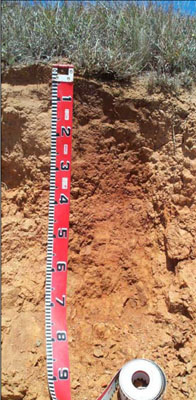EGW60
Location: Omeo
Australian Soil Classification: Eutrophic, Brown CHROMOSOL
Map Unit: Hinnomunjie (Component 2)
Previous Site Name: EG60
General Landscape Description: Rolling low hills
Site Description: Mid-slope (slope not specified)
Land Use: Grazing on annual pasture
Native Vegetation: Montane dry woodland
Geology: Ordovician metamorphosed sediments
Soil Profile Morphology:
| Surface soil |  | ||
| A1 | 0 – 10 cm | Dark brown (7.5YR3/2); fine sandy loam; weak polyhedral structure; gradual change to: | |
| A2 | 10 – 25 cm | Yellowish brown (10YR5/4) conspicuously bleached (10YR7/3); fine sandy clay loam; apedal; clear change to: | |
| Subsoil | |||
| B2 | 25 – 85 cm | Brown (7.5YR5/4) mottled with reddish brown (5YR5/4); medium clay; strong angular blocky structure; strong consistence dry; slight amounts (2 – 10%) large pebbles (20 – 60 mm) overlying decomposing rock. |
Key Profile Features:
- Strong texture contrast between the surface (A) horizons and the subsoil (B) horizons.
- Decomposing rock occurs in the deep subsoil.
Soil Profile Characteristics:
- | pH | Salinity | ||
Surface soil (A1 horizon) | Strongly Acid | Very Low | Non-sodic | None |
Subsurface soil (A2 horizon) | Moderately Acid | Very Low | Non-sodic | None |
Subsoil (B2 horizon) | Moderately Acid | Very Low | Non-sodic | None |
Chemical and Physical Analysis:
Horizon | Horizon Depth (cm) | pH (water) | EC dS/m | Organic Carbon % | Total Nitrogen % | Exchangeable Aluminium ppm | Exchangeable Acididty meq/100g | Exchangeable Cations | Coarse Sand (0.2-2.0 mm) % | Fine Sand (0.02-0.2 mm) % | Silt (0.002-0.02 mm) % | Clay (<0.002 mm) % | Field Capacity % w/w | Wilting Point % w/w | |||
Ca | Mg | K | Na | ||||||||||||||
meq/100g | |||||||||||||||||
A1 | 0-10 | 5.5 | 0.07 | 2.5 | 0.2 | <10 | 8.2 | 3.0 | 1.9 | 0.4 | 0.07 | 7 | 53 | 19 | 16 | 31.5 | 10.0 |
A2 | 10-25 | 5.6 | 0.06 | 15 | 6.0 | 2.2 | 2.1 | 0.23 | 0.07 | 9 | 54 | 17 | 21 | 28.4 | 7.6 | ||
B2 | 25-80 | 5.6 | 0.06 | 74 | 13.0 | 3.0 | 7.1 | 0.25 | 0.32 | 1 | 28 | 11 | 60 | 41.1 | 21.1 | ||
Management Considerations
Whole profile
- Infiltration of water though the upper part of the soil profile will be rapid due to the porous nature of the surface horizons.
- Plant available water content for this profile is considered to be moderate, based on a plant root depth of 65 cm.
- The clay content increases quite markedly at 25 cm.
Surface (A) horizons
- The low wilting point (10.0 and 7.6) of the surface soils indicates the plants are able to utilize very light rains when the soil is dry. However, due to the low water storage capacity, plants will soon suffer moisture stress unless further rains occur.
- The organic matter content of the soil is high. Such levels result in a good structural condition and good structural stability.
- The surface soil is moderately to strongly acid so a pasture response to lime would be likely. Deficiencies in phosphorus and molybdenum are also likely and lime applications would increase the availability of these nutrients.
- Potassium is bordering on deficient for pastures and a response to potassium fertiliser would be expected under rapid growing conditions
- Salinity is not a problem in the surface soil.
- The nutrient holding capacity of the surface horizons is low (based on the sum of the exchangeable calcium, magnesium, potassium and sodium cations). Organic matter is important for maintaining soil fertility on such soils.
Subsoil (B) horizons
- The subsoil and the deep subsoil are not sodic and do not disperse.
Soil Profile Described By: David Rees and Grant Boyle, 2000.


